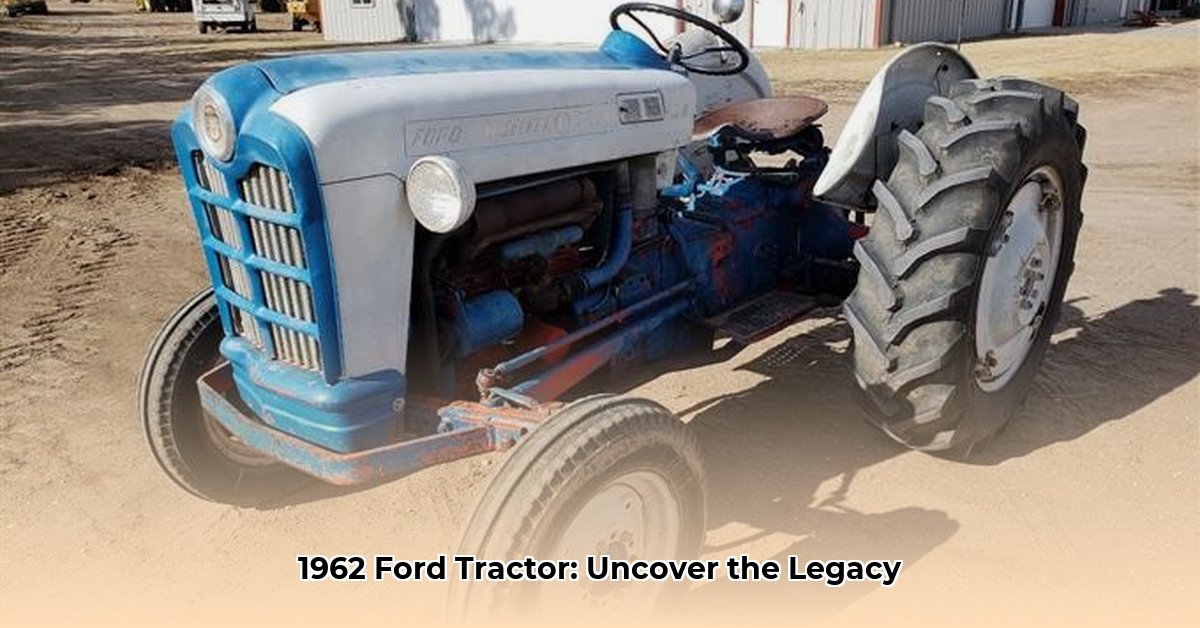
The Ford 4000 tractor, introduced in 1962, quickly became a mainstay on farms across America. Its robust design, versatile engine options, and innovative features cemented its legacy as a workhorse of the fields. This article delves into the history, specifications, and model variations of this iconic machine, providing a comprehensive overview for enthusiasts and historians alike. For even more information on Ford tractors, check out this great resource: Ford Tractor History.
The 1962 Ford 4000: A Technological Leap in Agriculture
1962 marked a turning point in agricultural technology. The Ford 4000 represented a significant advancement, offering farmers a powerful and reliable machine capable of handling the increasing demands of modern farming. Its impact extended beyond mere functionality; it represented a shift towards greater efficiency and ease of operation. Was it the most powerful tractor available? Not necessarily. However, its combination of power and ease of use made it exceptionally popular.
Engine Options: Power to the People (and the Fields)
A defining feature of the 1962 Ford 4000 was its choice of engines. Farmers were presented with a crucial decision: gasoline, diesel, or even liquid propane gas (LPG). This provided unprecedented flexibility, enabling farmers to choose a fuel source that best suited their needs and local availability. This flexibility, rare for its time, underscored Ford's commitment to meeting the diverse needs of its agricultural customers. Did this flexibility impact fuel consumption differently across models? Further investigation is needed to draw conclusive comparisons.
Transmission and Steering: Control and Comfort
Beyond engine power, the 1962 Ford 4000 prioritized ease of use. Farmers could opt for a standard manual transmission, a tried-and-true design, or Ford's innovative Select-O-Speed transmission. This option aimed to enhance operational smoothness and reduce driver fatigue during long working days in the fields. While the precise effects of these transmissions on operational efficiency are difficult to definitively quantify with the available data, anecdotal evidence suggests the Select-O-Speed was appreciated for its improved usability.
Body Styles: Adapting to the Terrain
Further showcasing its adaptability, the 1962 Ford 4000 was available in various body styles. The standard model was suited for open fields, while the row-crop version offered greater maneuverability in tighter spaces, crucial for working between rows of crops. This adaptability is a testament to Ford’s understanding of the diverse operational needs faced by farmers.
The Three-Point Hitch: A Revolution in Attachment
The simplicity of the three-point hitch belied its revolutionary impact. This standardized system enabled quick and efficient attachment of various implements — plows, harrows, balers, and more — streamlining operations and boosting overall productivity. It was a simple yet significant advancement, saving farmers considerable time and effort compared to older attaching mechanisms.
Specifications: A Detailed Look (with Caveats)
Due to limited archival data, precise specifications for every 1962 Ford 4000 model can be elusive. However, based on available information, we can paint a reasonably accurate picture of the tractor's characteristics. It's crucial to note that variations across models and fuel types will invariably exist.
| Specification | Typical Value | Notes |
|---|---|---|
| Engine Displacement | Approximately 2.8 Liters | Exact figures may vary based on engine type and model year. |
| Fuel Types | Gasoline, Diesel, LPG | Availability depended on regional factors. |
| Transmission | Manual, Select-O-Speed (optional) | Select-O-Speed offered more gears and smoother operation. |
| Three-Point Hitch | Category I or II | This standardized system simplified implement attachment. |
| Row-Crop Configuration | Available | Designed for narrower row spacing. |
Evolution of the Ford 4000: A Legacy of Innovation
Production of the Ford 4000 continued into the mid-1970s, with refinements and improvements implemented along the way. While pinpointing exact changes across each model year remains a challenge, the tractor’s longevity and enduring popularity speak volumes about its robust design and adaptability. What specific improvements were made over the years? Research remains underway to fully document these changes.
Comparing Ford 4000 Models: A Guide for Enthusiasts
The Ford 4000’s production run resulted in a range of models sporting diverse engines and transmissions. Comparing these models necessitates a careful examination of their specifications. Key factors for comparison include engine type (gasoline, diesel, LPG), transmission type (manual versus Select-O-Speed), and the three-point hitch’s lift capacity. This comparison will paint a comprehensive picture of the performance capabilities for each model variation. Additional research is encouraged to gather more precise model-specific data for comparative analysis.